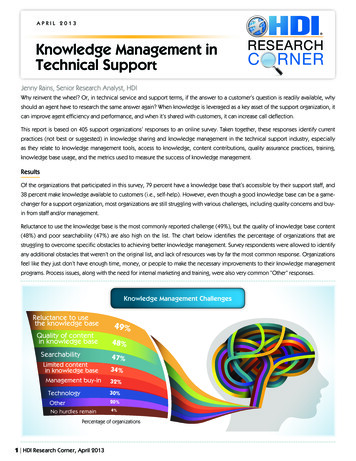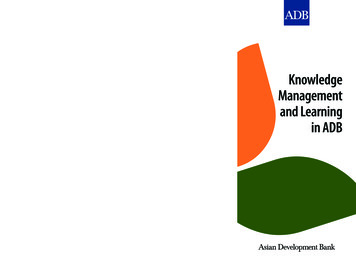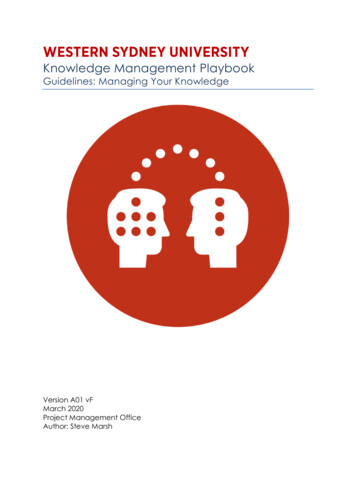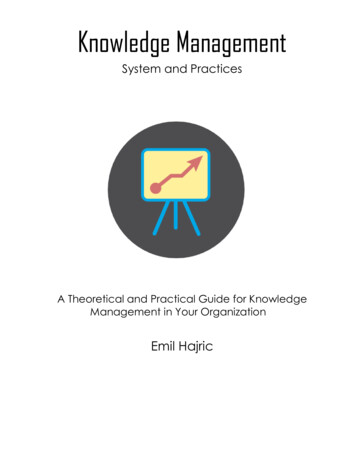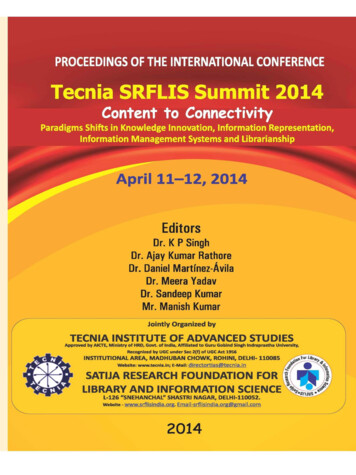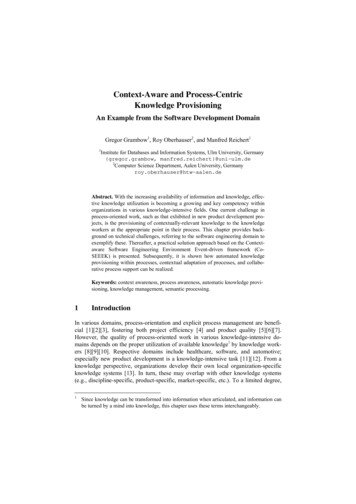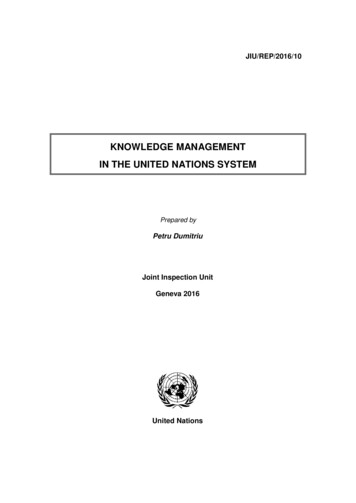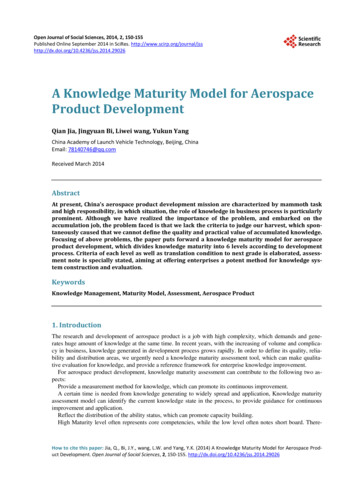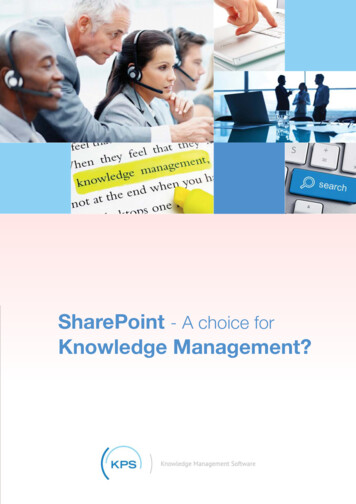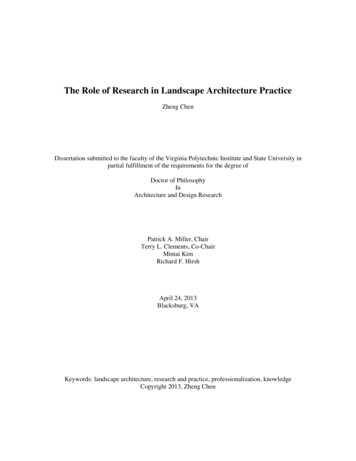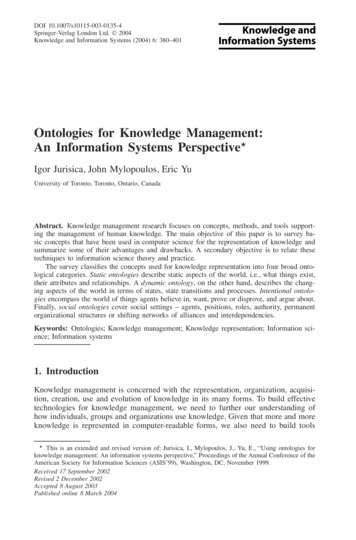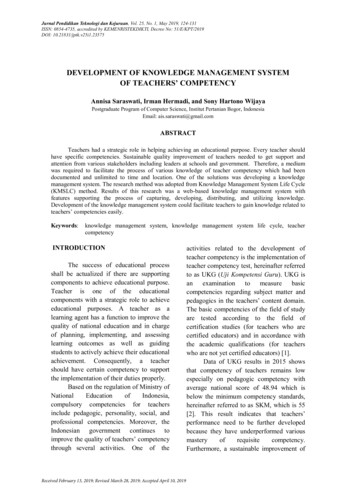
Transcription
Jurnal Pendidikan Teknologi dan Kejuruan, Vol. 25, No. 1, May 2019, 124-131ISSN: 0854-4735, accredited by KEMENRISTEKDIKTI, Decree No: 51/E/KPT/2019DOI: 10.21831/jptk.v25i1.23575124 Jurnal Pendidikan Teknologi dan Kejuruan,Vol. 24, No. 2, October 2018DEVELOPMENT OF KNOWLEDGE MANAGEMENT SYSTEMOF TEACHERS’ COMPETENCYAnnisa Saraswati, Irman Hermadi, and Sony Hartono WijayaPostgraduate Program of Computer Science, Institut Pertanian Bogor, IndonesiaEmail: ais.saraswati@gmail.comABSTRACTTeachers had a strategic role in helping achieving an educational purpose. Every teacher shouldhave specific competencies. Sustainable quality improvement of teachers needed to get support andattention from various stakeholders including leaders at schools and government. Therefore, a mediumwas required to facilitate the process of various knowledge of teacher competency which had beendocumented and unlimited to time and location. One of the solutions was developing a knowledgemanagement system. The research method was adopted from Knowledge Management System Life Cycle(KMSLC) method. Results of this research was a web-based knowledge management system withfeatures supporting the process of capturing, developing, distributing, and utilizing knowledge.Development of the knowledge management system could facilitate teachers to gain knowledge related toteachers’ competencies easily.Keywords:knowledge management system, knowledge management system life cycle, teachercompetencyINTRODUCTIONThe success of educational processshall be actualized if there are supportingcomponents to achieve educational purpose.Teacher is one of the educationalcomponents with a strategic role to achieveeducational purposes. A teacher as alearning agent has a function to improve thequality of national education and in chargeof planning, implementing, and assessinglearning outcomes as well as guidingstudents to actively achieve their educationalachievement. Consequently, a teachershould have certain competency to supportthe implementation of their duties properly.Based on the regulation of Ministry ofNationalEducationofIndonesia,compulsory competencies for teachersinclude pedagogic, personality, social, andprofessional competencies. Moreover, theIndonesian government continues toimprove the quality of teachers’ competencythrough several activities. One of theReceived February 13, 2019; Revised March 28, 2019; Accepted April 10, 2019activities related to the development ofteacher competency is the implementation ofteacher competency test, hereinafter referredto as UKG (Uji Kompetensi Guru). UKG isan examination to measure basiccompetencies regarding subject matter andpedagogics in the teachers’ content domain.The basic competencies of the field of studyare tested according to the field ofcertification studies (for teachers who arecertified educators) and in accordance withthe academic qualifications (for teacherswho are not yet certified educators) [1].Data of UKG results in 2015 showsthat competency of teachers remains lowespecially on pedagogic competency withaverage national score of 48.94 which isbelow the minimum competency standards,hereinafter referred to as SKM, which is 55[2]. This result indicates that teachers’performance need to be further developedbecause they have underperformed variousmasteryofrequisitecompetency.Furthermore, a sustainable improvement of
Saraswati et al., Development of Knowledge Management System of Teachers’ Competency 125teachers’ competency needs support andattention from various parties including theschools.Additionally, according to theacquisition of teachers’ competency testresults of SMK Pembangunan Bogor in2018, there are only 2 out of 5 teachers whosucceeded to meet SKM in the competencytest [2]. This shows that teachers’competency of SMK Pembangunan Bogorstill needs to be developed. Various trainingshave been implemented to develop theteachers’ competency. However, the resultof the UKG indicates that the trainings werenot effective. It might be happen becauseeducators have limited time to participate inthe trainings due to their minimumcompulsory requirement of classroomactivities. Knowledge gap occurs betweensenior teachers and new teachers becausethere is no process of knowledgetransferring. Knowledge and experience ofthe teachers have not been documented. Thiscauses the difference of competency whileteaching. Therefore, a medium is required tofacilitate the process of knowledge sharingwithout limitation of time and location. Oneof the solutions is developing knowledgemanagement system as a medium ofknowledge sharing and source of teachers’competency learning.Knowledge management system iswidely used in other fields namely finance,business and industries [3]–[5]. Ineducational sectors, previous studies relatedto a knowledge management system alsohave been done. Yang [6] implemented ablog-based knowledge management systemto support learning process, which revealedthat it may help creating and fosteringknowledge. Mardhia & Langi [7] built aknowledgemanagementsystemonlesson study activities to manage teacher’sknowledge related to lesson study activities.Moreover, Maman et al. [8] developed awebsite of learning system using knowledgemanagement system as media for sharingknowledge to improve competencies of earlychildhood teachers. Sari [9] also designed aknowledge management system to supportthe accreditation process of an educationalinstitution .Based on the existing problems, theresearcher will develop a knowledgemanagement system, hereinafter referred toas KMS of teachers’ competency at SMKPembangunanBogor. Developing aknowledge management system becomesnecessary for SMK Pembangunan Bogor asa medium to share knowledge amongteachers, facilitate in documenting andgaining knowledge related to teachers’competency as well as media of learning.Learning feature is also equipped withmultiple choice exercises on each learningactivity.METHODThis study adopted KnowledgeManagement System Life Cycle (KMSLC)method from Awad & Ghaziri [10]. Itconsisted 6 stages starting from evaluatingthe existing infrastructure to verify andvalidate the model. It is presented in Figure1.Evaluating the existing infrastructurestage is the analysis of knowledge andhuman resources as well as analysis oftechnology and information infrastructure,network infrastructure, and application thatis currently running at the school. Formingthe knowledge management team stagerefers to selecting and assigning teammembers to involve in the modeldevelopment.
126 Jurnal Pendidikan Teknologi dan ay 20192018framework Code igniter as well as data basisMySQL.Thisstagealsoverifiescompleteness and validity of knowledge byexperts and validate functionality of thesystem using a black-box testing approach.RESULTS AND DISCUSSIONFigure 1. Research StagesFurthermore, knowledge capturingstage is an activity to classify the explicitand tacit knowledge according to theteacher’s competencies aspects. Explicitknowledge refers to a knowledge that hasbeen saved as a document, book, or report[10]. Tacit knowledge is the knowledgethat is still in the mind of knowledgeresource itself (experts) that is obtainedthrough interview [10].Designing knowledge managementblueprint stage starts from knowledgecodification using a knowledge map anddesigning a knowledge management systemusing an object-oriented approach model ofthe Unified Modeling Language (UML).The design has four main elementsincluding data, architecture, interface, andcomponent ystemisconversion of the blueprint into PHPprogram code language programming withAll teachers of SMK PembangunanBogor has been equipped with computerfacilities with LAN (Local area Network)internet connection and Wi-Fi connectionwhich allow all computers at the school tobe interconnected. Internet network on theschool environment is provided by two ISPs(Internet Service Provider) with sufficientspeed (20 and 30 Mbps).SMK Pembangunan Bogor currentlydoes not have a software system to save andmanage knowledge related to teachers’competency. According to observationresults at SMK Pembangunan Bogor, theexisting knowledge related to teachers’competency is in the form of electronic,non-electronic document, or knowledge thathas not been documented from the experts’experience. Available human resourcesrelated to teachers’ competency at SMKPembangunan Bogor is presented in Table 1.Table 1. Availability of Human ResourcesDepartmentInformationPrincipalVice principal of curriculumVice principal of student affairsCounseling teacherHomeroom teacherProductive tExpertData resourceThe knowledge management team inschools involves vice principals, homeroomteachers,counselingteachers,andproductive teachers as teachers’ competencyexperts, information technology techniciansas administrator, and researchers as
Saraswati et al., Development of Knowledge Management System of Teachers’ Competency 127knowledge management system developers.Process of capturing knowledge isimplemented using SECI model fromNonaka & Takeuchi [12] shown in Table 2.Table 2. Process of Capturing Teacher CompetencyKnowledgeToFromTacitTacitExplicit- Interview and- Documentingdiscussion withknowledge derivedexpertsfrom experts- Observation of - Knowledge is savedlearning process into databaseExplicit - Document- Document in the formchecking byof non-electronic intoexpertselectronicBased on the process of capturingknowledge that has been implemented,results shows that knowledge resource isdivided into two locations namely (1)teacher and (2) Artifacts. Knowledge is inthe form of idea, skill, training, independentlearning, and experience during teaching.Knowledge of pedagogic competency isderived from vice principal of achers.Knowledgeofprofessional competency is derived fromproductive teachers, multimedia skillscompetency, accounting and e, as well as online business andmarketing. The knowledge is categorized astacit knowledge that can be seen on Table 3.Knowledge that exists in artifact is inthe form of documented files related toteachers ‘competency of pedagogic andprofessional aspects. Those knowledge arecategorized as explicit knowledge. The formof this knowledge maybe electronic (E) andnon-electronic (Non-E) explained in Table4. Knowledge codification representationresults using knowledge map can be seen inFigure 2. exercises on each learning activity.The forum feature can be used by systemusers to interact and discuss with other usersregarding a topic or issue.Table 3. Tacit knowledgeDepartmentTacit knowledgeVice- Expert in developing studentsprincipal ofpotentialstudentaffairsViceprincipal ofcurriculum- Expert in implementing reflectiveaction to improve learning quality- Expert in organizing learningprocess according to studentscharacteristicsCounselingteacher- Expertincommunicatingeffectively, empathetically andpolitely with students.Homeroomteacher- Expert in potential identification,initial capability, and learningdifficulties of students.Productiveteacher- Expert in utilizing informationand communication technologyfor learning interests.- Expert in implementing variousapproaches, strategic, methods,and technique of learning thatcreatively educating.- Expert in developing learningmaterial of teaching creatively.inorganizing- Experiencecompetency test for students.inparticipating- Experiencesubjectsteachersforum,musyawarah guru mata pelajaran(MGMP), and so forth.Usecasediagramdescribesinteraction between one or more actors withsystem [13]. Actors in this system includesexperts, teachers, and administrators. Allactors need to login to access the existingfeatures in the system. Each actor has a
128 Jurnal Pendidikan Teknologi dan ay 20192018different access right. Details of accessrights can be seen in Figure 3 while thedomain class diagram that shows relationsbetween classes can be seen in Figure 4.Table 4. Explicit knowledgeExplicit knowledge- Teacher discipline- Learning module of pedagogiccompetency- Learning module of professionalmultimedia competency, accountingand financial institutions, automationand office governance, onlinebusiness and marketing- Operational procedure of handling ofstudents- Annual and semester programs- Corecompetencyandbasiccompetency of every expertiseprogram.- Basic competency mapping- Syllabus for each subject- Lesson plan- Minimum completion criteria- Aspects and procedures of learningoutcomes assessment- Analysis and instrument of learningoutcomes assessment- Linkage analysis between graduatecompetencystandard,corecompetency, and basic competency ofknowledge and skills- Documents of observation, issues, andvisitation of student’s guardian.Document typeNonEE form of articles and share the articles withother users. Learning feature means learningmedia for teacher in the form of presentationdocument files, learning module, and videofiles related to teachers’ competency.Learning feature is also equipped withmultiple choice. Architecture system onFigure 5 using architecture model with 6layers adopted from architecture system ofAwad & Ghaziri [10]. PrincipalTeacher disciplineOperational procedureof handling students Module of teacherlearning for pedagogicand professionalcompetencyReflective action toimprove learningqualityViceprincipal ofcurriculumStudents characteristicPedagogiccompetencyVice principalof studentaffairsCounselingteacherTeachercompetency ofSMK PembangunanBogorHomeroomteacherPotential developmentof studentsEffectivecommunicationIdentification ofpotential, initialcapability, and learningdifficultiesDocument ofobservation, issue, andstudent visit Functional need of software from amanagementsystemofteachers’competency knowledge, hereinafter referredto as SIMAPKG, includes features of edocument, articles, learning, and discussionforum. The e-document feature facilitatesusers to share explicit knowledge in the formof document. The article feature facilitatesusers to document tacit knowledge in theDocument ofcurriculumdevelopmentUse of information andcommunicationtechnology in ject materialdevelopmentEducational learningStudents’ competencytestDocuments of learningassessment andevaluationSubject teacher forumactivities (MGMP)Figure 2. Knowledge Map of Teacher Competency
Saraswati et al., Development of Knowledge Management System of Teachers’ Competency 129Figure 3. Use Case of SIMAPKGThe verification stage is carried out byinterviewing experts regarding completenessand validity of knowledge. Verificationresults stated that knowledge inserted to thesystem is valid and related to aspects ofteachers’ competency. Validation stage isdone by examining application of aknowledge management system using ablack-box tes conducted by experts andadministrators.System development is done on thelocalhost network using the help fromXampp software with PHP languageprogramming and Codeigniter framework aswell as a MySQL database. System displayfor e-document, articles, and learning menuwith users’ role as teachers can be seen inFigure 6, Figure 7, and Figure 8.Figure 4. Domain Class Diagram of SIMAPKGFigure 6. Display of Teacher E-Document PagesFigure 5. Architecture of SIMAPKGFigure 7. Display of teacher article pages
130 Jurnal Pendidikan Teknologi dan ay 20192018[2][3]Figure 8. Display of teacher learning pages[4]CONCLUSIONThis study has successfully developeda knowledge management system ofteachers’ competency named SIMAPKG.Knowledgemanagementsystemisdeveloped using KMSLC that is objectoriented and implemented using CodeigniterframeworkwithPHPlanguageprogramming and MySQL database.SIMAPKG is developed as a media to shareknowledge and teachers’ competencylearning media for pedagogic andprofessional aspects. SIMAPKG is a webbased system with feature to support processof capturing, developing, sharing, andutilizing knowledge. Features to supportthose processes among others are edocument, article, learning, and forum.Results of black-box testing shows that thesystem is effectively functioned andconvenient with users’ needs Further systemdevelopment can be developed by managingall aspects of teachers’ competency thatincludes personality and social aspectscompetencies and is expected to implementa knowledge management system and assessthe effectiveness of the use of the knowledgemanagement system.REFERENCES[1]Ministry of Education and Culture,[5][6][7][8][9]Pedoman Uji Kompetensi GuruTahun 2013. Jakarta: Ministry ofEducation and Culture, 2013.Directorat General of Teachers andEducation Personnl, “Hasil UjiKompetensi Guru 2015,” Jakarta,2015.A. Riskinanto, “Perancangan ModelKnowledge Management Systempada Helpdesk Support VP-ASP diRocksaltPty.Ltd.,”UniversitasIndonesia, 2013.A. Rahmawati, “Sistem ManajemenPengetahuan Penyelesaian KerugianNegara (Studi Kasus: LAPAN),”Institut Pertanian Bogor, 2015.A. Y. Prasetyo and Harisno,“Knowledge management systemdevelopment at PT Bussan AutoFinance,” in 2016 11th InternationalConferenceonKnowledge,Information and Creativity SupportSystems (KICSS), 2016, pp. 1–10.X. Yang, “Improving Teachers’Knowledge Management with BlogPlatform,” in 2008 InternationalWorkshop on Education Technologyand Training & 2008 InternationalWorkshop on Geoscience andRemote Sensing, 2008, pp. 73–76.M. M. Mardhia, A. Z. R. Langi, andY.Bandung,“KnowledgeManagement System Developmentwith Evaluation Method in ceonAdvanced Computer Science andInformation System, 2014, pp. 482–487.U. Maman, Y. Sugiarti, and S.Ratnawati, “Learning System DesignUsing Knowledge ManagementSystems to Improve the Competencyof Early Childhood EducationTeachers,” in 2016 4th InternationalConference on Cyber and IT ServiceManagement, 2016, pp. 1–6.R. Sari, “Perancangan ModelKnowledge Management Systemuntuk Mendukung Proses Kerja
Saraswati et al., Development of Knowledge Management System of Teachers’ Competency 131[10][11]Akreditasi: Studi Kasus LembagaAkreditas Mandiri Pendidikan TinggiKesehatan,” Universitas Indonesia,2014.E. M. Awad and H. M. Ghaziri,“Knowledge Management SystemsLifeCycle,”inKnowledgeManagement, 2nd ed., New Jersey:Pearson Education, Inc., 2007, itoner’sApproach (Seventh Edition). NewYork: The McGraw-Hill Companies,Inc., 2010.[12][13]I. Nonaka and H. Takeuchi, “TheoryofOrganizationalKnowledgeCreation,” in The KnowledgeCreating Company: How JapaneseCompanies Create the Dynamics ofInnovation, Oxford: Oxford, 1995,pp. 56–94.R. A. Sukamto and M. Shalahuddin,“Pemodelan dan UML,” in RekayasaPerangkatLunak,Bandung:Informatika, 2013.
(KMSLC) method. Results of this research was a web-based knowledge management system with features supporting the process of capturing, developing, distributing, and utilizing knowledge. Development of the knowledge management system could facilitate teachers to gain knowledge related to teachers' competencies easily.
